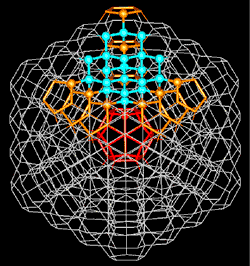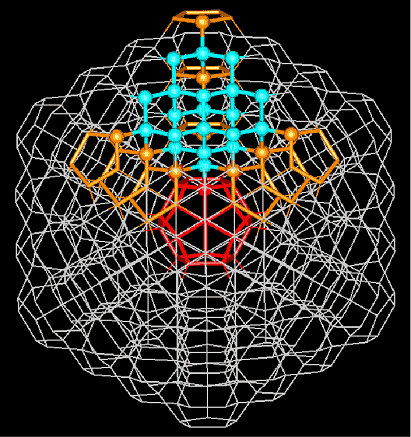New Symmetry for Silicon
A hypothesized new form of silicon is no mere chip off the old block. Several hundred silicon atoms can join to form a nanometer-sized particle unlike any silicon crystal ever seen, researchers predict in the 2 July PRL. The hypothesized nanoparticle–a 20-sided polyhedron–should behave like an artificial atom and could power better light sources and detectors–if experimenters can figure out how to make it.
In the past 25 years, several bizarre solid forms of common elements and compounds have emerged. In 1985 researchers discovered that carbon can form not only graphite and diamond, but also spherical cages of 60 atoms arranged in a soccer-ball pattern, which are known as buckyballs. In 1982 researchers discovered that certain alloys, such as a particular mixture of aluminum and manganese, form patterns that are almost, but not quite, crystalline. These “quasicrystals” contain sets of five atoms arranged in pentagons, and although the patterns reappear throughout the structure, each instance is slightly different, so that a quasicrystal lacks the regular repeating structure of an ordinary crystal.
In something of a cross between a buckyball and a quasicrystal, several hundred silicon atoms can form an icosahedron–a polyhedron with 20 triangular faces–predict Yufeng Zhao, Shengbai Zhang, and their colleagues, at the National Renewable Energy Laboratory in Golden, Colorado. The new structure consists of 20 small crystalline tetrahedrons–pyramids with four triangular sides–that fit together a bit like sections of an orange. All twenty tips nearly meet in the center of the particle, where the atoms form a cage with 12 pentagonal sides. As with the buckyball, the solid looks a bit like a soccer ball. And as with the quasicrystal, it’s an orderly solid formed of a non-repeating pattern containing pentagons.
To prove that the new structure will be stable, the researchers compared it theoretically to two little chunks of crystalline silicon with different shapes. One shape minimized the number of loose chemical bonds dangling from the surface of the silicon; the other made the silicon particle as round as possible. Using a technique called density functional theory, the researchers calculated the energy stored within each structure. For particles containing fewer than a few thousand atoms and measuring less than 5 nanometers across, the icosahedral particle had the lowest energy and was therefore most stable.
Just as in individual atoms, the electrons trapped inside nanoparticles emit and absorb light of discrete wavelengths, which makes them useful sources and detectors of light. Zhao and Zhang’s calculations show that, because they are more symmetrical than crystalline nanoparticles, the icosahedral nanoparticles are even choosier about the wavelengths of light they emit and absorb, which could make them even better than crystalline nanoparticles for some purposes.
The prediction is intriguing, says Mark Swihart, a chemical engineer at the State University of New York at Buffalo. But the question is whether the new nanoparticles can be made, he says, and that may be tricky. On the other hand, Swihart says, it’s possible that the weird little bits of silicon are lying around in samples of nanoparticles that he and others have already synthesized. “Maybe if we look hard enough at these samples and knew what we were looking for, maybe these are already there.”
–Adrian Cho
Adrian Cho is a freelance science writer in Grosse Pointe Woods, Michigan.
More Information
Focus story on quasicrystals, with links to quasicrystal web sites





